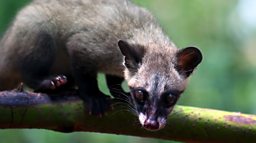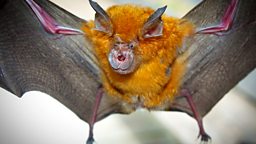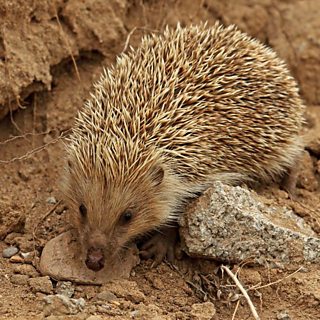Covid鈥檚 origin: five animals with clues to the mystery
It’s one of the biggest questions of our time: where did Covid come from? It’s also one of the most controversial. The hunt for an answer has become toxic, politicised, and polarised.
In Fever: The Hunt for Covid’s Origin, the 大象传媒’s ex-China correspondent John Sudworth investigates, speaking to leading scientists from all sides of the debate and reporting on-the-ground – from the streets of Wuhan to the inside of a high-security laboratory in the US.
Here, the podcast’s producer Simon Maybin looks at five animals caught up in the arguments about the origin of Covid.

Listen to Fever: The Hunt for Covid's Origin

Palm civets
Sometimes called the civet cat, the palm civet is a small, furry, wide-eyed mammal with a face a bit like a raccoon. In 2003, scientists identified palm civets as the animal that was most likely to have first passed another deadly new virus – Sars – to humans.
Sars (short for Severe Acute Respiratory Syndrome) appeared in China in late 2002 and ended up killing nearly 800 people around the world. It was caused – just like Covid – by a coronavirus, and the evidence suggested it made the jump from palm civets to people working in the trade in wild animals for food.
So when, at the end of 2019, cases of an unexplained pneumonia turned up in the Chinese city of Wuhan, people were on high alert for a connection to the wildlife trade. This new disease, later named Covid, was also caused by a coronavirus and some of the early cases were people who shopped or worked at a Wuhan market.
Bats
Bats are of huge interest to scientists studying viruses that might cause pandemics. These virus hunters go out into the wild to catch bats and take samples of their bodily fluids and faeces to study. Wang Linfa, a professor of emerging infectious diseases at Duke-NUS Medical School in Singapore, tells us he calls those samples “liquid gold” because they contain so much information about the viruses that bats carry.
Professor Wang and his colleagues discovered after the 2002 Sars outbreak that bats are the normal host animal for the particular type of coronavirus that caused that disease. He says that another animal – like a palm civet – can easily pick a bat virus up from bat faeces on the ground.
The Covid virus, it’s almost certain, also originated ultimately in bats. But how exactly it made its journey from bats to humans is a deeply controversial and highly-contested question.

Humans
You might have heard of the “lab leak theory” – the idea that the first person to catch Covid got it in some kind of research-related accident.
The term “lab leak” has actually been used to describe a whole range of scenarios. At one extreme is the idea that Covid was designed and purposefully released as a biological weapon – few people believe that makes any sense. At the other end, there’s the possibility that a virus-hunting scientist picked it up directly from a bat, either in a lab or while collecting samples in the wild.
Scientists also experiment with bat coronaviruses when they take them back to the lab, manipulating them in petri dishes or in animals to see how they might evolve. The aim is to learn more about the viruses so that we can be better prepared for or even prevent future pandemics.
But some scientists think the benefits of this work are outweighed by the risks. “It’s interesting,” says Jesse Bloom, an evolutionary virology professor from the Fred Hutch Cancer Center in Seattle, “but it’s not a good idea.”
He says that by hunting for the most dangerous viruses, “you're also potentially increasing the exposure of the people doing that work to those viruses.”
There’s more than one laboratory in Wuhan that did work on bat coronaviruses and the possibility that the Covid pandemic was started by a human at one of them is understandably highly contentious. While some scientists think it’s a possibility that shouldn’t be ruled out, others say there’s overwhelming evidence that that’s not what happened.
Amur hedgehogs
Closely-related to the European hedgehog but slightly lighter in colour, the amur hedgehog’s role in the hunt for Covid’s origin is that of a plot-twisting cameo.

In early 2021, a group of international scientists visited Wuhan as part of a World Health Organisation mission to find out where Covid came from. They worked alongside a group of Chinese scientists and one of the focuses of their attention was the Wuhan market connected to some of the first cases.
An obvious question, given how Sars emerged in 2002, was what animals were for sale at the market? Were there live mammals – like palm civets – susceptible to these kinds of coronaviruses?
Despite reports suggesting otherwise, the WHO mission said they’d found no verified evidence of live mammals being kept in the market.
But later in 2021 a scientific paper was published with evidence of a radically different picture. It was based on a survey of four markets in Wuhan – including the one the WHO focused on – that found that between May 2017 and November 2019, more than 47,000 animals had been sold, including an average of 332 amur hedgehogs every month.
They were the most popular mammal, but others for sale included Siberian weasels, masked palm civets, and complex-toothed flying squirrels.
The study suggested the Chinese authorities had been trying to hide the true nature of the wild animal trade in Wuhan prior to the pandemic. China says it’s been “open and transparent” in the search for Covid’s origin.
Raccoon dogs
Another animal with a raccoon-like face, the raccoon dog has long hair and is related to dogs and foxes. It too featured in the survey of Wuhan’s markets and has been the subject of recent headlines suggesting the origin of Covid had finally been found.
It all comes down to samples gathered by Chinese scientists in early 2020 at that Wuhan market linked to some of the first Covid cases. It took more than three years for some of the data to be published, leading to more accusations that China was trying to withhold vital information.
When the data was published, it showed that traces of animal DNA – including that of raccoon dogs – had been found at various locations in the market. And one analysis focused on a sample that contained both raccoon dog DNA and traces of the Covid virus.
The authors argued that – although not proof – the data suggested that the “most likely” explanation for the origin of Covid was that an infected raccoon dog had passed the virus to a human in that market.
But another analysis questioned that conclusion, saying that finding genetic material from an animal and the virus together was “unlikely to reliably indicate whether any animals were infected” by the Covid virus.
In a story full of claims and counter-claims, it’s just another example of the division and confusion on a question that remains crucially important to our species.
Follow John Sudworth’s quest to find the origin of Covid in Radio 4’s hit podcast series, Fever: The Hunt for Covid's Origin.

-
![]()
Fever: The Hunt for Covid's Origin
Cover-ups, coincidences, and conspiracy theories: where did Covid come from?
-
![]()
The Covid Inquiry
Everything you may have missed in the Covid Inquiry this week.
-
![]()
Yeti
Is something out there in the Himalayas? Two enthusiasts set off to discover whether the yeti is real.
-
![]()
The Banksy Story
The story of Banksy's rise from secretive street artist to international icon.




